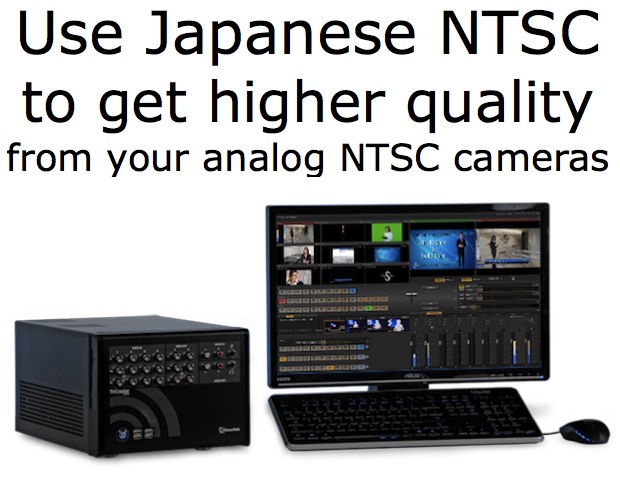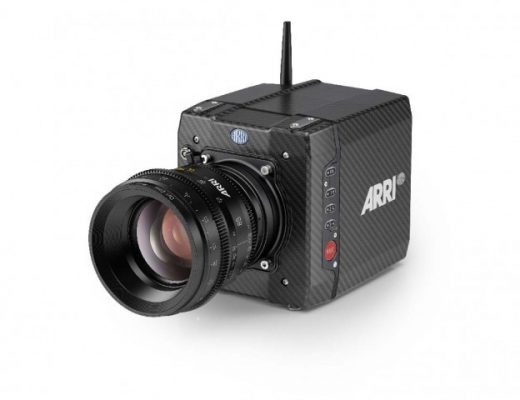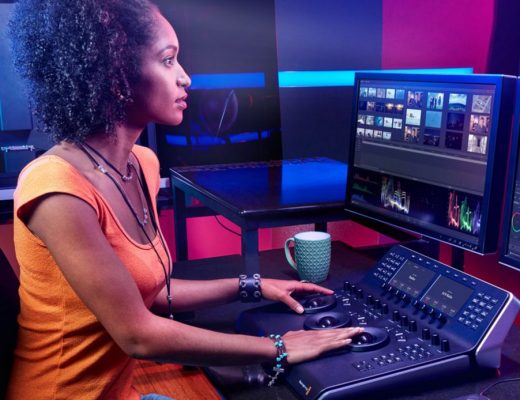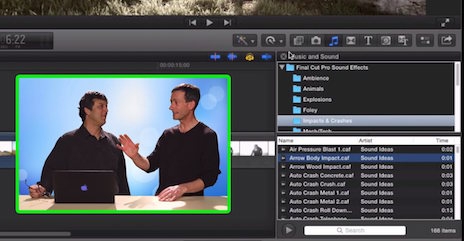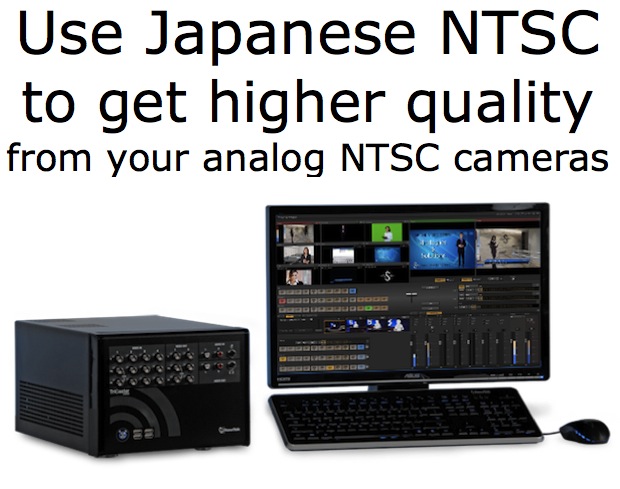
Whether or not you enjoy Sushi or other Japanese food (as I do), you are best served by using Japanese NTSC if you use a TriCaster 40 with SD NTSC cameras, even if you live in the Americas. The reasons for this go back to a topic I first covered a decade ago in the palindromic year of 2002, when I published a 3-page print article called Los negros todavía no tienen igualdad in the Latin American magazine Producción & Distribución. It has to do with black video levels and the varied presence or absence of pedestal (setup) in analog PAL, analog NTSC video in the Americas, analog NTSC video in Japan, digital video worldwide, and HD video worldwide. Coincidentally, about a week after I published that article, Adam Wilt published a similar, 1-page article in DV magazine, called We’ve been set up!. Later JVC Professional released an awesome tutorial called Dirty Little Secrets about the same topic, which apparently was inspired by my article. Ahead I’ll review this topic and explain why and how you should go Japanese if you use SD NTSC cameras with a TriCaster 40.
In this article
- 2002 articles that introduce the issue
- Why the TriCaster 40 has caused a return of this “retro” issue
- A very concise summary of the situation
- 8-bit distribution formats which represent the majority
- JVC’s Dirty little secrets about black video levels, pedestal, and setup
- How the waveform monitor works in TriCasters (when present)
- Why it is better to set your cameras for Japanese NTSC
- How to send the best, cleanest Japanese NTSC signal to the TriCaster
- Conclusions
2002 articles mentioned above
For those of you who read Castilian (aka “Spanish”) and are interested in reading my original 2002 article called Los negros todavía no tienen igualdad, here’s a link to a PDF. I don’t currently have access to a copy of Adam Wilt’s 2002 article We’ve been set up!, but if that changes, I’ll add a link later.
Why the TriCaster 40 has caused a return of this “retro” issue
Unlike many other HD video mixers (“switchers”) on the market today, the TriCaster 40 has only analog video inputs (no digital video inputs). Despite that fact, the TriCaster 40 will undoubtedly become extremely popular since it offers so much power for so little, while it greatly simplifies system creation. First, we’ll cover how to assure proper black levels, especially when crossing from the analog to the digital world, from whichever analog SD NTSC cameras you have (or digital ones where you must use the analog output). Later we’ll cover the Japanese NTSC trick you’ll likely end up using to get better quality from your analog SD NTSC camera when used with the TriCaster 40.
A very concise summary of the situation
For historical reasons that go beyond the scope of this article, 7.5 ire (as opposed to zero ire) has traditionally been part of the analog NTSC signal in NTSC-countries in the Americas, but it has never existed in analog NTSC in Japan (sometimes called NTSC-J), in analog PAL in any country, in analog HD of any type in any country, or in digital video (SD or HD) of any type in any country. In any digital 8-bit video códec/format/system, standard black level must always, always, always be at digital level 16 in any country on Planet Earth (regardless of whether an SD analog connection may or may not have 7.5 ire pedestal/setup, depending upon other factors). In any digital 10-bit system, the standard black level must be at digital level 64. In fact, the standard black level on an HD-SDI signal from an HD camera must always be digital level 64, regardless of where the HD camera is sold or delivered anywhere in the world, since the HD-SDI standard is always 10-bit (even though certain HD cameras actually derive the 10-bit signal from an internal 8-bit signal, even in live mode). However, SDI is irrelevant to the TriCaster 40 since it has no SDI connections. Although internal processing in all TriCasters is handled either natively (to match the source material, if ingested digitally as a file or via SDI on higher-end TriCasters) or in floating point space, the two primary distribution/interchange video files created/exported by the TriCaster are 8-bit. So for the purpose of our conversation, our Prime Directive is to make sure that all black levels entering the TriCaster 40’s camera inputs end up at the proper black digital level, which must eventually become level 16 when streaming and/or when recording a digital file in any of two primary distribution/interchange códecs/formats offered by the TriCaster 40, which are currently QuickTime MPEG2 i-frame at 4:2:2, or H.264 at 4:2:0). (The current exception is NewTek’s own SpeedHQ códec/format with alpha channel at up to 4:4:4:4 much higher than 8-bit, primarily for internal use within the TriCaster, although also available for Mac.) Below you’ll see all of the distribution formats which are also 8-bit and therefore must also receive the digital darkest black level at 16 too.
8-bit distribution formats which represent the majority
Although there are many benefits to using 10-bit códecs/formats —or beyond— (especially when advanced grading is to take place) with formats and códecs like Adobe’s open CinemaDNG (used in the Blackmagic Cinema Camera), Apple’s ProRes422 and its variants, Avid’s DNxHD, Canon’s Cinema Raw, Panasonic’s AVC-Intra 100 & AVC-Ultra, and Sony’s S-Log (and monitoring 10-bit in an advanced grading system), we must recognize that the majority of distribution formats are 8-bit, like:
- All DTV over the air and cable TV formats I’ve ever seen so far, including all creative variants used in Latin America
- Blu-ray
- DVD
- H.264 web and mobile video
For all of the above 8-bit delivery systems/formats, they need to have the same darkest black level at digital level 16, which will match all of the currently available interchange códecs/formats currently offered by the TriCaster, anywhere digital video currently exists on Planet Earth. For best quality, it’s important to assure that the level be correct upon digitization of the analog signal. That’s what I’ll be covering ahead in this article.
JVC’s Dirty little secrets about black video levels, pedestal, and setup
This awesome JVC production (click here to view it on the JVC page) was apparently inspired by my Los negros todavía no tienen igualdad article from 2002. Although it completely excludes the international issues (analog Japanese NTSC, analog PAL, and HD of all types) that Adam and I covered in our respective articles, it does a great job of covering the issues as they were focused in 2002, when most cameras sold were SD, analog video was frequently being digitized and going back to analog videotape, when some semi-professional DV25 cameras were unfortunately being manufactured with a design flaw that often created improper black levels at digital level 32 if the camera operator wasn’t aware and therefore didn’t compensate, and when much over-the-air broadcast in the USA was still analog and still required 7.5 ire. (Because of the confusion and the camera design flaws, some black levels were improperly broadcast at 15 ire, as mentioned in the JVC Dirty little secrets video above.) JVC did an amazing job at compressing so much information in such a short, entertaining video.
By 2009 that situation had changed drastically in the USA, since all but certain LPTV (low power television) stations were required to cease analog transmissions, and the latest info I have indicates that even those who got temporary exceptions will have to cease by September 1, 2015. But even if you work at one of those few stations that still broadcast analog NTSC (or at cable TV station that modulates analog), or are in another country in the Americas that still allows analog NTSC TV broadcasts, this information will still be very useful to you. I’ll be covering your situation too!
On page 2 of this article:
- How the waveform monitor works in TriCasters (when present)
- Why it is better to set your cameras for Japanese NTSC
- How to send the best, cleanest Japanese NTSC signal to the TriCaster
- Conclusions
Click here for page 2 of this article…;
How the waveform monitor works in TriCasters (when present)
Unlike the waveform monitors in modern video editing (i.e. Final Cut Pro X) and grading programs (i.e. DaVinci Resolve) which are primarily designed to show information about the digital video file being edited and therefore never include a 7.5 ire marker on their graticule, TriCaster’s waveform monitor has been designed to represent the analog video output of the TriCaster. This reminds me of classic hardware-based non-linear video editing systems like the dpsVelocity system, which behaved the same way (with respect to the waveform monitor). As a result, when the TriCaster is displaying its waveform monitor in a standard definition NTSCsession (Sessions in TriCaster are like projects or sequences in your favorite video editing app), it shows a 7.5 marker on its virtual graticule, since it represents the analog black level that has been added to the analog output. Since with a standard-definition NTSC session, the TriCaster is properly adding 7.5 ire on its analog output, this 7.5 level on the waveform monitor will match the appropriate digital black level in floating point (I don’t know what the number is in floating point, but it doesn’t matter), and later translate it to digital level 16 after you export to one of the mentioned distribution/interchange códecs/formats, since they are currently all 8-bit.
The waveform monitor in a TriCaster (when present) behaves quite differently when it is a session in NTSC-J, PAL, or any type of HD session. (USA-segregated TriCaster models don’t offer NTSC-J or PAL sessions.) First, in those cases, there is no 7.5 ire marker, and second, the black level on the graticule will eventually translate to digital level 16 after you export to one of the mentioned distribution/interchange códecs/formats will be zero, not 7.5. When I wrote most of this article, I incorrectly believed that the TriCaster 40 included a waveform monitor. Later I discovered that it doesn’t include one, but I have maintained the waveform monitor explanations in this article, in case NewTek ever adds the scopes to the TriCaster 40 via a software update (I really hope they do), or in case you apply this information to any higher-end TriCaster which does include a waveform monitor.
Why it is better to set your camera for Japanese NTSC
It is better to set your analog SD NTSC camera to Japanese NTSC because you will take better advantage of the full dynamic range from zero to 100 ire, rather than only using the more limited dynamic range from 7.5 to 100. I began adjusting studios this way many years ago when clients were using analog SD NTSC cameras to feed hybrid video mixers and then recording to a DV25 format (not broadcasting live). To accomplish that, I switched both the camera heads to Japanese NTSC (aka NTSC-J) and the digital video mixer (which had analog inputs).
How to set your cameras for Japanese NTSC
If you are using consumer analog NTSC cameras, they are likely already using Japanese NTSC, and therefore you have nothing special to do at the camera end, other than to get a good and proper exposure. If you are using consumer NTSC cameras and do find a zero/7.5 option in the menu, set it to zero. Otherwise, just skip to the next section to make your adjustments in the TriCaster, if necessary.
If you are using old prosumer DV25 cameras like the Panasonic AG-HVX100 or Sony PD150/PD150/DSR–250, simply set the zero/7.5 option to zero (which is what was recommendable anyway to compensate for their design flaw to avoid recording improper DV recordings on the internal tape).
If you are using other, higher end analog NTSC cameras, check the manual. In many cameras that I had to adjust, it was a DIP switch or rotary switch in the camera. It might be called NTSC-J, it might be called zero setup, or (if the camera has component analog output, which is the best possible output for the TriCaster 40), it might be called SMPTE (as opposed to Beta, Beta-USA, Betacam, or Betacam-USA). If you select SMPTE, this will also affect the chroma saturation, but that will be easily compensated, and is described ahead in this article. I know very well that the SMPTE level is a level that was abandoned in NTSC countries in favor of Sony’s special “Betacam USA” levels, but that is irrelevant to this situation. Our goal is to get the best analog component signal to the TriCaster 40 in a closed system, nothing more. All other levels used (both analog on the TriCaster 40’s output, and digital to exported files) will have modern, accepted levels.
How to send the best, cleanest Japanese NTSC signal to the TriCaster
- Always light well and get the proper exposure in the camera. Check out Art Adams’ articles about lighting.
- Always use component analog (three cables, often colored as Red, Green, and Blue) if available from the camera head or CCU (Camera Control Unit). The next choice is Y/C (aka “S-Video”), and the last choice is composite video.
- If you have a CCU (Camera Control Unit) or a mini-CCU, use it to set everything as perfectly as possible from the camera before using the TriCaster’s own individual ProcAmp (processor amplifier) for each input. For best quality, always use the TriCaster’s ProcAmp last (keep it it all at nominal/default settings when adjusting the camera via the CCU or mini-CCU).
- When adjusting the camera with the CCU or mini-CCU, while looking at the TriCaster’s waveform monitor (if present), adjust first black level, then gain, then (in the case of a full CCU) cable compensation to set color saturation on the TriCaster’s vectorscope (if present).
- Only after exhausting all adjustments from the camera (via the CCU or mini-CCU), use the TriCaster’s ProcAmp to tweak further, if necessary.
If you have a multi-standard TriCaster 40 and are not broadcasting live analog NTSC in the Americas, use an NTSC-J session, and use zero ire on the TriCaster 40’s waveform monitor (if present) as your desired black level when making the above adjustments. If you have a multi-standard TriCaster 40 and you are broadcasting live analog NTSC in the Americas, read ahead.
If you have a segregated 59.94 Hz TriCaster (or a multi-standard one and you are broadcastinglive analog NTSC in the Americas, use an NTSC session and use 7.5 as your desired black level on the TriCaster 40’s waveform monitor. Either way, this will assure that your streaming digital black level and creating exported 8-bit files have the proper black level, and if you are one of the few who still broadcast analog SD NTSC over the air or over cable, you’ll have the proper levels too. If you have no waveform monitor or vectorscope in your TriCaster, then adjust as best as possibly by eye, or purchase an external video monitor with built-in scopes.
Conclusions
The purpose of this article has been both to get both proper black levels and the highest possible quality from the old analog SD cameras with the TriCaster 40, which only has analog inputs, of which the best is component analog in SD. In HD, component analog is the only option, and the adjustment procedure shown in the last section still applies, although the target black level on the TriCaster waveform monitor (if present) will always be zero with an HD session.
To make sure you continue to see my upcoming articles, sign up to my mailing list here.
My latest ebook
I have just published an ebook in two languages.
The format is Kindle, but even if you don’t have a Kindle device, you can read Kindle books on many other devices using a free Kindle app. That includes iPad, iPhone, Android phones, Android tablets, Mac computers, Windows computers, some Blackberry phones and Windows 7 phones.
In English:

In English, it is currently available in the following Amazon stores, depending upon your region:
- At Amazon.com (for all of the Americas and the Republic of India)
- Amazon.co.jp (Japan)
- Amazon.co.uk (United Kingdom)
- Amazon.de (Germany)
- Amazon.es (Spain, pero a lo mejor lo prefieres en castellano, a continuación)
- Amazon.fr (France)
- Amazon.it (Italy)
If you’re going to buy a Kindle book as a gift, you must do so via the Pan-American Amazon store (the first one listed above), regardless of where you live or where the recipient lives.
En castellano:
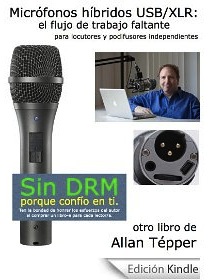
En castellano, está disponible actualmente en las siguientes tiendas Amazon, según tu región:
- Amazon.com (todas las Américas y la República de la India)
- Amazon.co.jp (Japón)
- Amazon.co.uk (Reino Unido)
- Amazon.de (Alemania)
- Amazon.es (España)
- Amazon.fr (Francia)
- Amazon.it (Italia)
Si vas a comprar un libro Kindle como regalo, debes hacerlo vía la tienda panamericana de Amazon (la primera de la lista) sin importar donde vivas tú o donde viva la persona que recibirá el regalo.
Allan Tépper’s books, consulting, articles, seminars & audio programs
Contact Allan Tépper for consulting, or find a full listing of his books, articles and upcoming seminars and webinars at AllanTepper.com. Listen to his TecnoTurprogram, which is now available both in Castilian (aka “Spanish”) and in English, free of charge. Search for TecnoTur in iTunes or visit TecnoTur.us for more information.
Disclosure, to comply with the FTC’s rules
No manufacturer is specifically paying Allan Tépper or TecnoTur LLC to write this article or the mentioned books. Some of the other manufacturers listed above have contracted Tépper and/or TecnoTur LLC to carry out consulting and/or translations/localizations/transcreations. Many of the manufacturers listed above have sent Allan Tépper review units. So far, none of the manufacturers listed above is/are sponsors of the TecnoTur programs, although they are welcome to do so, and some are, may be (or may have been) sponsors of ProVideo Coalition magazine. Some links to third parties listed in this article and/or on this web page may indirectly benefit TecnoTur LLC via affiliate programs.
Copyright and use of this article
The articles contained in the TecnoTur channel in ProVideo Coalition magazine are copyright Allan Tépper/TecnoTur LLC, except where otherwise attributed. Unauthorized use is prohibited without prior approval, except for short quotes which link back to this page, which are encouraged!

Filmtools
Filmmakers go-to destination for pre-production, production & post production equipment!
Shop Now